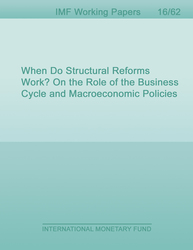
When Do Structural Reforms Work? On the Role of the Business Cycle and Macroeconomic Policies
Structural reforms are expected to lift growth and employment, but their effects are surprisingly difficult to pin down empirically. One reason is their potential endogeneity to the economic environment in which they are conducted. For example, the impact of a reform implemented shortly before a cyclical upswing is difficult to distinguish from the recovery itself. Similarly, macroeconomic policies conducted along a structural reform could affect the estimated impact. Exploring various options, this paper develops robust estimates of the impact of labor and product market reforms by using local projection techniques while controlling for endogeneity of reforms and other biases. The results suggest that labor and product market reforms have a lagged but positive impact on employment creation, and the positive effect remains even after controlling for the endogeneity of the decision to reform. Supportive macroeconomic policies are found to increase the effect of labor and product market reforms, consistent with the view that some structural reforms are best initiated in conjunction with supportive fiscal or monetary policy.
Publication date: March 2016
ISBN: 9781513589923
$18.00
Add to Cart by clicking price of the language and format you'd like to purchase
Available Languages and Formats
| English |
Prices in red indicate formats that are not yet available but are forthcoming.
Topics covered in this book
This title contains information about the following subjects.
Click on a subject if you would like to see other titles with the same subjects.
Economics- Macroeconomics , Economics / General , International - Economics , Structural reforms , employment , monetary policy , fiscal policy
Summary
Copyright © 2010 - 2024
Powered by:
AIDC



